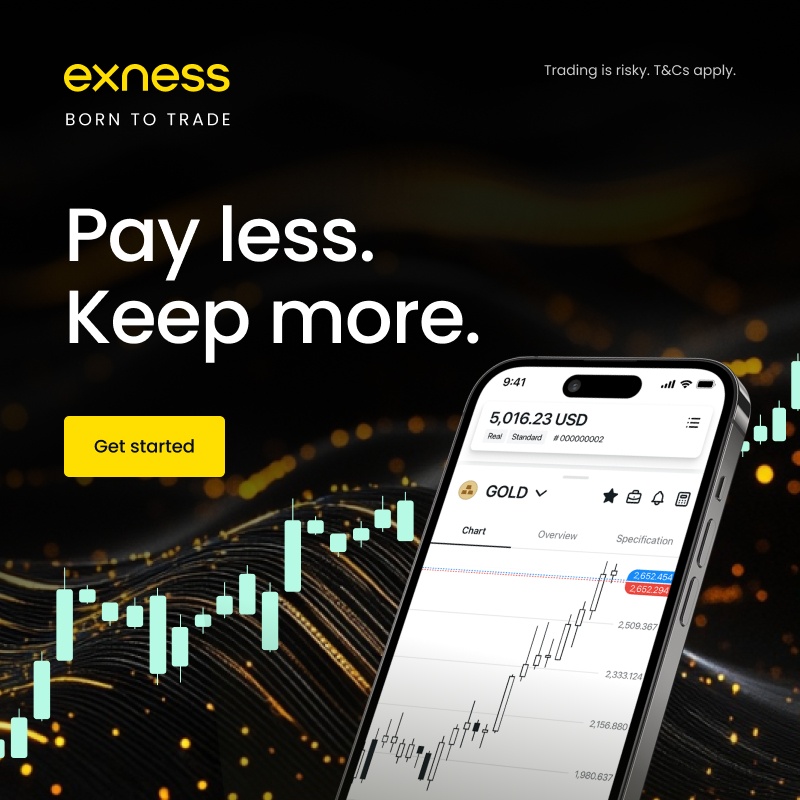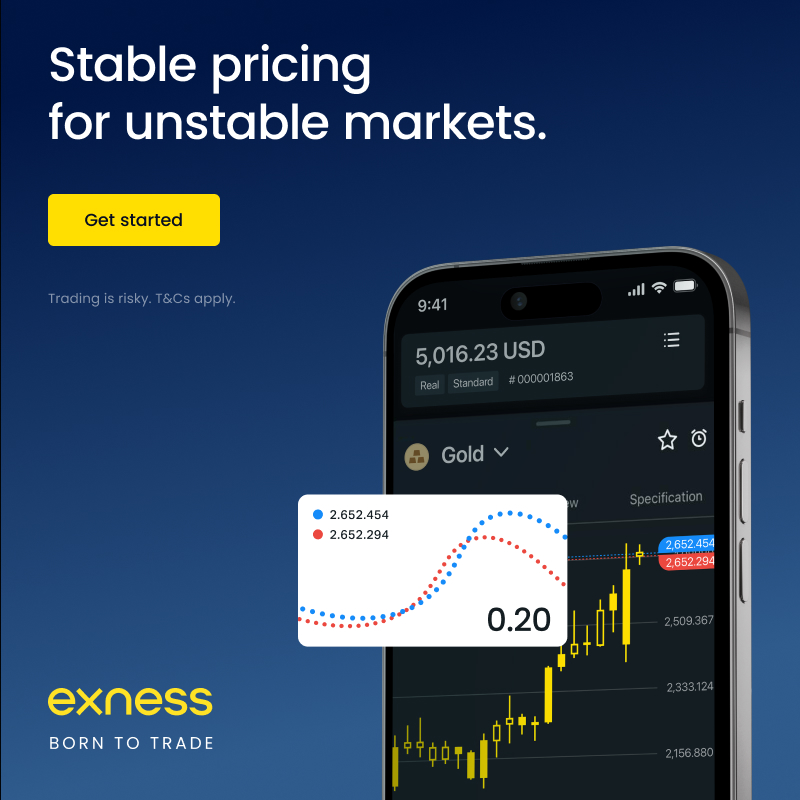
8 minute read
How to Trade on Exness for Beginners: A Comprehensive Guide
from Exness Blog
Trading in financial markets can seem intimidating, especially for beginners. However, platforms like Exness have made it easier than ever for newcomers to dive into trading with confidence. Exness, a globally recognized forex and CFD broker, offers a user-friendly interface, competitive trading conditions, and a wealth of resources tailored for beginners. In this guide, we’ll walk you through everything you need to know to start trading on Exness, from setting up an account to placing your first trade and managing risks effectively. Whether you’re interested in forex, stocks, commodities, or cryptocurrencies, this guide will equip you with the knowledge to begin your trading journey.

💥 Trade with Exness now: Open An Account or Visit Brokers 🏆
· are traded in pairs (e.g., EUR/USD). The first currency is the base, and the second is the quote currency. For example, in EUR/USD at 1.1000, one Euro equals 1.10 US Dollars.
· Spreads: The difference between the buy (ask) and sell (bid) price. Exness offers tight spreads, reducing trading costs for beginners.
· Lot Sizes: A standard lot is 100,000 units of the base currency, but beginners can trade micro-lots (1,000 units) to minimize risk.
· Leverage: Exness provides flexible leverage, allowing you to control larger positions with less capital. However, high leverage increases both potential profits and risks.
· Risk Management: Tools like stop-loss and take-profit orders help limit losses and lock in profits.
Familiarize yourself with these terms to make informed decisions when trading.
Step 2: Sign Up for an Exness Account
To start trading, you need to create an Exness account. Follow these steps:
· Visit the Exness Website: Go to the official Exness website exness.com and click the “Sign Up” button. Ensure you’re on the legitimate site to avoid phishing scams.
· Fill in Your Details: Provide your email address, phone number, and personal information. Use accurate details, as they’ll be verified later.
· Choose Your Account Type: Exness offers several account types:
· Standard Account: Ideal for beginners with low spreads and no commissions. Minimum deposit is $1.
· Cent Account: Perfect for practicing with micro-lots and smaller trade sizes.
· Pro, Zero, or Raw Spread Accounts: Better suited for experienced traders but available if you want tighter spreads.
· Complete KYC Verification: Submit identification documents (e.g., passport, utility bill) for account verification, which typically takes a few hours.
· Set Up a Demo Account: Before trading with real money, open a demo account to practice in real market conditions without financial risk.
Once your account is verified, you’re ready to proceed.
Step 3: Fund Your Exness Account
To trade with real money, you need to deposit funds. Exness offers multiple payment methods, including:
· Bank transfers
· Credit/debit cards
· E-wallets like Skrill and Neteller
· Cryptocurrency deposits
How to Deposit:
· Log into your Exness Personal Area.
· Click “Deposit” and select your preferred payment method.
· Enter the amount (as low as $10 for some accounts) and choose your base currency (e.g., USD, EUR, INR).
· Follow the prompts to complete the transaction. Deposits are usually instant.
Exness’s multi-currency accounts eliminate conversion fees, which is especially helpful for traders in countries like India.

💥 Trade with Exness now: Open An Account or Visit Brokers 🏆
Step 4: Choose a Trading Platform
Exness offers several platforms to suit different trading styles:
· MetaTrader 4 (MT4): Popular for forex trading, with customizable charts and technical indicators.
· MetaTrader 5 (MT5): Offers advanced features, including more order types and access to stocks and indices.
· Exness WebTrader: A browser-based platform that requires no downloads, ideal for quick trades.
· Exness Trade App: A mobile app for iOS and Android, perfect for trading on the go.
How to Set Up:
· Download your chosen platform (MT4/MT5 for desktop/mobile or access WebTrader via browser).
· Log in using the credentials provided during account creation.
· Explore features like Market Watch (for real-time prices), charts, and order entry tools.
For beginners, MT4 or the Exness Trade App are recommended due to their simplicity.
Step 5: Analyze the Market
Successful trading requires market analysis. Exness provides tools for two main types of analysis:
· Technical Analysis: Use charts and indicators (e.g., Moving Averages, RSI, MACD) on MT4/MT5 to predict price movements. Exness platforms offer customizable charting tools powered by TradingView.
· Fundamental Analysis: Monitor economic events, such as interest rate changes or GDP reports, using Exness’s economic calendar and market news.
Tips for Beginners:
· Focus on major currency pairs (e.g., EUR/USD, GBP/USD) due to their high liquidity and tight spreads.
· Start with one or two instruments to avoid overwhelm.
· Practice analyzing trends on a demo account before trading live.
Step 6: Place Your First Trade
Once you’ve analyzed the market, you’re ready to place a trade. Here’s how:
· Select an Instrument: Choose a currency pair, stock, or commodity from the Market Watch window.
· Open the Order Window: Click “New Order” or tap “Trade” on the Exness Trade App.
· Set Trade Parameters:
· Order Type: Choose a market order (executed instantly at the current price) or a limit order (executed at a specific price).
· Lot Size: Start with a micro-lot (0.01) to minimize risk.
· Stop-Loss and Take-Profit: Set these to manage risk and lock in profits. For example, a stop-loss at 20 pips below your entry price limits potential losses.
· Choose Buy or Sell: Buy if you expect the price to rise; sell if you expect it to fall.
· Confirm the Trade: Click “Buy” or “Sell” to execute. Monitor your trade in the “Trade” tab.
Step 7: Manage Your Trades
After placing a trade, monitor its performance using real-time data on your platform. Exness offers tools to adjust trades:
· Modify Orders: Swipe left on an open order to adjust stop-loss or take-profit levels.
· Close Trades: Close a trade manually by clicking the “Close” button or let stop-loss/take-profit orders execute automatically.
· Risk Management: Use Exness’s Stop Out Protection to delay or avoid forced closures due to insufficient margin.
Step 8: Withdraw Your Profits
Exness’s instant withdrawal feature is a standout. To withdraw:
· Log into your Personal Area.
· Click “Withdrawal” and select your payment method.
· Enter the amount and confirm. Most withdrawals are processed instantly or within minutes.
Tips for Successful Trading on Exness
· Start with a Demo Account: Practice trading strategies risk-free to build confidence and skills.
· Develop a Trading Strategy: Use simple strategies like moving average crossovers or support/resistance levels to guide trades.
· Manage Risk: Risk only 0.5–1% of your account per trade and use stop-loss orders consistently.
· Stay Informed: Follow market news and economic events via Exness’s resources to anticipate price movements.
· Avoid Overtrading: Focus on quality trades rather than quantity to prevent unnecessary losses.
· Leverage Promotions: Check Exness’s promotions page for bonuses like deposit boosts to enhance your capital.
· Join a Community: Engage with trading communities (e.g., Frank’s Community) for insights and signals.
Common Mistakes to Avoid
· Overleveraging: High leverage can amplify losses. Start with low leverage (e.g., 1:50) and increase as you gain experience.
· Ignoring Risk Management: Always set stop-loss orders to protect your capital.
· Trading Without a Plan: Develop and stick to a strategy to avoid impulsive decisions.
· Chasing Losses: Accept losses as part of trading and avoid increasing trade sizes to recover quickly.
· Neglecting Education: Continuously learn through Exness’s webinars, tutorials, and articles.
Exness Features That Benefit Beginners
· Copy Trading: Follow and replicate trades from successful traders to learn and potentially profit.
· Free VPS Hosting: Run automated strategies without keeping your device on, available for eligible accounts.
· 24/7 Customer Support: Access help via live chat, email, or phone whenever you need assistance.
· Low Spreads: Competitive spreads reduce trading costs, especially on major forex pairs.
· Flexible Leverage: Choose leverage that matches your risk tolerance, from 1:1 to unlimited (depending on account type and region).
Trading Instruments on Exness
Exness offers a variety of instruments for diversification:
· Forex: Over 100 currency pairs, including major, minor, and exotic pairs.
· Stocks: Trade CFDs on large-cap companies like Apple, Amazon, and Microsoft.
· Commodities: Includes gold, oil, and metals like silver and platinum.
· Indices: Trade major indices like the S&P 500 or NASDAQ.
· Cryptocurrencies: Access up to 35 crypto pairs as CFDs.
Beginners should start with highly liquid instruments like EUR/USD or gold to benefit from tight spreads and high trading volume.
Risk Warning
Trading involves significant risks, especially with leveraged products like CFDs. You could lose all your invested capital. Only trade with money you can afford to lose, and ensure you understand the risks before opening a live account. Exness’s demo account is an excellent way to practice without financial exposure.
Conclusion
Trading on Exness as a beginner is an exciting opportunity to explore global financial markets. With its low entry barriers, user-friendly platforms, and robust educational resources, Exness empowers newcomers to start trading confidently. By following this guide—setting up an account, funding it, choosing a platform, analyzing the market, placing trades, and managing risks—you’ll be well on your way to building a successful trading journey.
💥 Note: To enjoy the benefits of the partner code, such as trading fee rebates, you need to register with Exness through this link: Open An Account or Visit Brokers 🏆
Read more:

